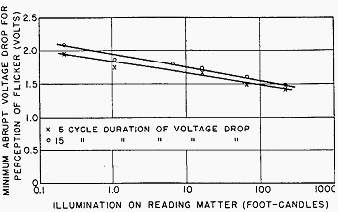Why Lamp Flickers Sometimes
Voltage regulation
Voltage regulation has been one of the most important problems of the electric industry since its inception. The sizes of many parts of a power system are determined largely by this one consideration alone.
Large proportion of the selling price of electrical power is the interest and other fixed charges on production and distribution facilities, so that any improvement in regulation is ultimately reflected in higher rates.
Similarly, types of load imposing exceptionally severe regulation requirements will also increase the cost of supplying energy.
In the early days of the industry, a relatively wide range of voltage variation was permissible, because the public was at that time unaccustomed to uniform lighting intensity. Today, there is a greater consciousness as to whether the voltage level is about right, as indicated by the “whiteness” of the light and by lamp life.
While, however, a narrower voltage band is required than formerly, this is not always the limiting factor in voltage regulation. fSumerous new devices have been added to power lines in the last few years, which impose rapid and frequent changes of load, with correspondingly rapid voltage changes.
Repeated observations have shown that rapid changes of voltage are much more annoying than slow ones, so that “flicker” effects may limit the useful load-carrying ability of individual circuits long before maximum steady-state regulation or heating is reached.
Consequently, the voltage regulation problem must now he considered from two angles:
- The normal drop in voltage from light load to full load, and
- The superimposed flickers due to motor-starting and to various pulsating and irregular loads.
The differences in voltage between light and full load affect the performance, efficiency, and life of electrical equipment.
This article considers only the flicker component of voltage regulation, and deals primarily with the reaction of the human eye to variations in electric light intensity.
Permissible Flicker
The permissible amount of flicker voltage cannot be stated concisely for several reasons.
There is first the human element; one individual may think objectionable a flicker not perceptible to another. The lighting fixture used is of considerable importance. Smaller wattage incandescent lamps change illumination more quickly upon a change of voltage than lamps with heavier filaments.
The character of the voltage change is also important.
Cyclic or rapidly recurring voltage changes are generally more objectionable than non-cyclic. On non-cyclic changes the annoyance due to the flicker is affected by the rate of change, duration of change, andfrequency of occurrence of the flicker.
These and other factors greatly complicate the problem of assigning limits to permissible flicker voltages.
Numerous investigators have studied the flicker problem. The most complete analysis is found in the report “The Visual Perception and Tolerance of Flicker” prepared by Utilities Coordinated Research, Inc. and printed in 1937, from which Figures 1 to 4 of this article are reproduced.

Figure l - Cyclic pulsation of voltage at which flicker of 115~volt tungsten filament lamp is just perceptible-derived from 1104 observations by 95 persons in field tests of 25-watt, 40-watt, and 60-watt lamps conducted by Commonwealth Edison Company.
Figure 1 above shows the cyclic pulsation of voltage at which flicker of 115 volt tungsten-filament lamp is just perceptible. Flickers as low as 1/3 volt were perceptible in 10 percent of the observations, when the rate of variation was 8 cycles per second.
In order for the variations to be perceptible in 90 percent of the observations, however, the voltage change had to be over one volt at the same frequency. The range between 6 and 12 cycles per second was the most critical.

Figure 2 - Illumination on reading matter (foot candles)
Figure 2 shows the minimum abrupt voltage dip to cause perceptible flicker in a 60-watt, 120-volt tungsten-filament lamp, as a function of intensity of illumination.
Curves are shown for 5 and 15 cycles (GO cycles per second basis) durations of voltage dip. It should be noted that abrupt voltage dips of 1.5 to 2.0 volts were perceptible.

Figure 3 - Effect of duration of transition of voltage on average threshold of perceptibility of flicker of tungsten-filament lamps
Figure 3 shows the effect of “duration of transition” of voltage on the average threshold of perceptibility of flicker for tungsten-filament lamps. This curve shows quite cIearly that whereas an abrupt change of about 1 ½ volts is perceptible, a change of 5 volts or more is necessary before voltage variations requiring several seconds for completion can he perceived.
Figures 1 to 3 are of interest in showing the perceptibilities for various classes of flicker voltages. These are not working limits, because a perceptible flicker is not necessarily an objectionable one.

Figure 4 - Recommended maximum allowable cyclic variation of voltage
Figure 4 above shows the recommended maximum allowable cyclic variation of voltages as set up by various nllthorities for their own use. The variations in these recommendations is an indication of the extent to which individual judgment enters the problem.
The curves are nevertheless an exceedingly valuable guide.
Cyclic flicker, when perceptible, is likely to be objectionable, at least to some individuals.
Isolated voltage dips, however, even if plainly perceptible, are not objectionable to the majority of individuals unless rather frequent. It can, therefore, be expected that larger variations are permissible for non-cyclic than for cyclic variations, but that the amount of tolerable dip depends upon the frequency of occurrence and the class of service.

No comments:
Post a Comment